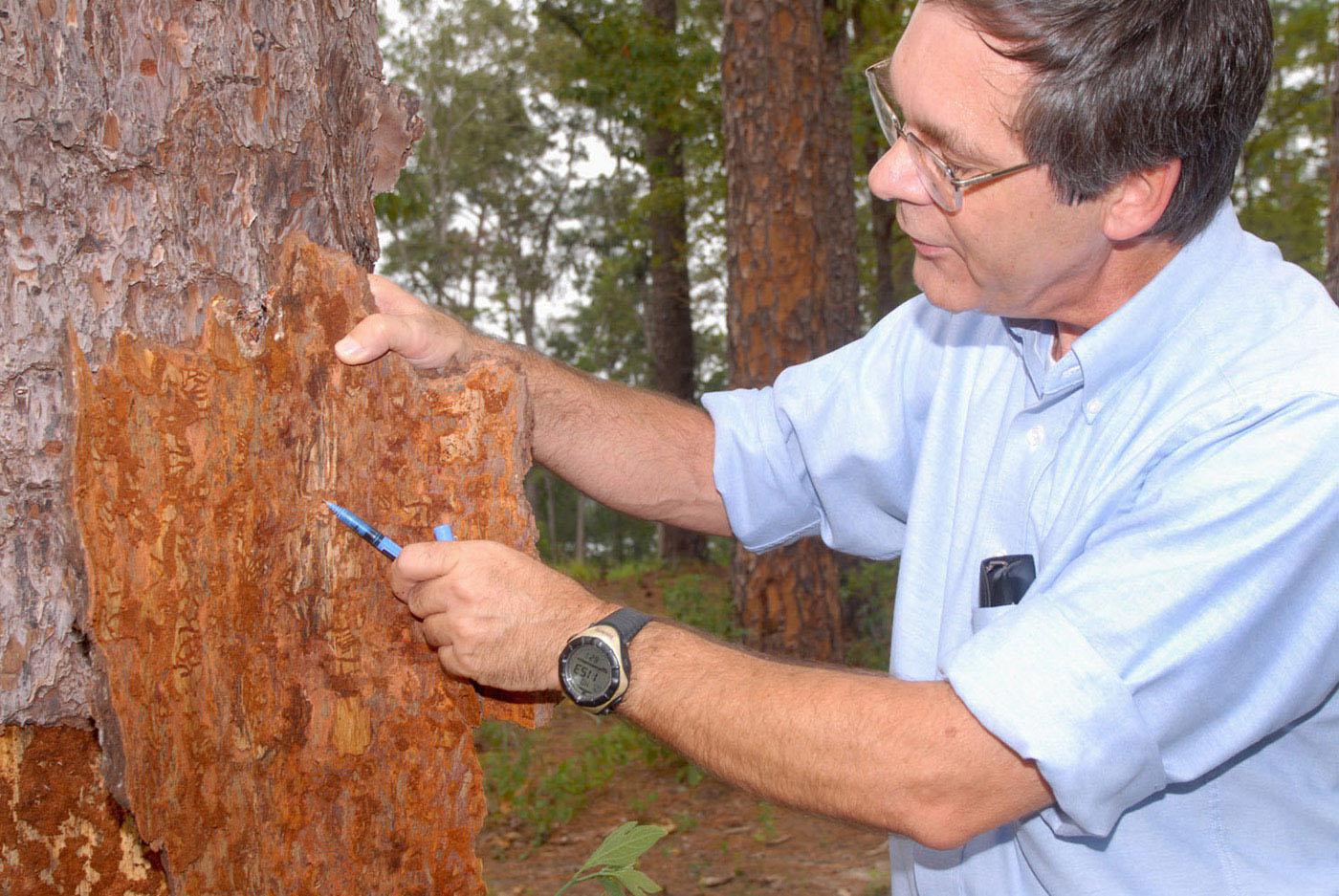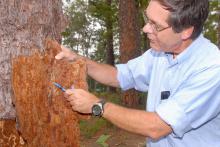Information Possibly Outdated
The information presented on this page was originally released on August 24, 2006. It may not be outdated, but please search our site for more current information. If you plan to quote or reference this information in a publication, please check with the Extension specialist or author before proceeding.
Foresters advise keeping a close watch on beetles
MISSISSIPPI STATE-- Take high temperatures, drought and forest fires, add the woody debris caused by Hurricane Katrina and the result is the recipe for South Mississippi's worst bark beetle outbreak in more than a decade.
“Pine trees are severely stressed due to the hurricane and the drought that followed,” said Glenn Hughes, Mississippi State University Extension Service forester. “Pine bark beetle populations exploded immediately after Katrina as beetles infested snapped pine trees. Last fall, these beetles moved into isolated live trees due to the post-Katrina drought.”
This summer's drought is rated severe or extreme for South Mississippi and has resulted in increased numbers of forest fires, adding to the stress on trees, Hughes said.
Coastal areas subjected to the storm surge from Katrina have the greatest tree mortality, with thousands of dead trees documented in the area.
“This is particularly troublesome because the individuals who have lost their homes may be living in temporary trailers and in many cases have exhausted their financial reserves,” Hughes said. “They now find that their pine trees are dead or dying.”
There are different types of pine bark beetles, and some are more destructive than others. According to Hughes, the majority of pine bark beetle infestations so far have been in timber snapped or downed by Katrina.
“Ips, or Engraver beetles, about half the size of a grain of rice, infest downed timber, living between the bark and the wood,” he said. “The problem occurs when Ips beetles begin attacking live trees that are stressed by drought, lightning, or other factors. Damage is generally restricted to a few trees, but can affect several acres. This damage can be costly to both forest landowners and homeowners.”
A second type of pine bark beetle, the southern pine beetle, is rated the most destructive pine bark beetle in the South. It fortunately has not been seen in great numbers this year and is typically not a problem in South Mississippi.
A third type of bark beetle is the black turpentine beetle, which generally is found in the lower 8 feet of the tree, often around wounded areas on the bark. This bark beetle is the least destructive of the three, Hughes said, and the easiest to control. It is also the largest of the three, about the size of a grain of rice.
“The most effective prevention technique involves maintaining healthy pine trees,” he said. “For forest landowners, this consists of thinning at the appropriate time to reduce stress and thus insect attacks.”
Homeowners may need to water trees once a week during a drought period. Watering trees with 1 inch of water each week during a drought is better than more frequent, less intense watering.
Hughes said landowners should pay close attention to their trees so those infested can be identified and removed promptly. Signs of infestation by bark beetles include the needles turning from dark green to yellowish green to reddish brown. Another telltale sign is the appearance of globs of sap on the bark called “pitch tubes.” These indicate where the beetle bored into the tree.
Mark Anderson, general manager of Hattiesburg-based Karnes Tree Service and certified arborist, has assisted more than 50 landowners this summer in removing trees from landscapes due to storm damage, drought and bark beetles.
“Black turpentine beetles colonized trees damaged during the hurricane clean-up that occurred this spring,” Anderson said. “Once the black turpentine beetles come in, the Ips and southern pine beetles are not too far away.”
Southern pine beetles are moving from tree top to tree top in the landscape and spraying has little to no value, Anderson added.
Homeowners should look for any signs of stress in the crown of the trees and contract with a tree service to remove infested trees promptly.
“Inaction will allow the beetles to move to neighboring pine trees, infesting them, and resulting in more dead trees and greater removal costs to the homeowner,” Anderson advised.
Beetle activity typically increases in the fall as temperatures moderate, Anderson said, so the bark beetle situation may get worse before it gets better.
“Needles on many trees infested by beetles are just starting to turn, so landowners and homeowners need to become familiar with signs of infestation in order to identify, treat, and stop the beetles,” he added.
A series of evening meetings are being planned in South Mississippi to educate landowners and homeowners about the threat from bark beetles, as well as control measures. For information on upcoming meetings, contact Hughes at (601) 794-0671.




